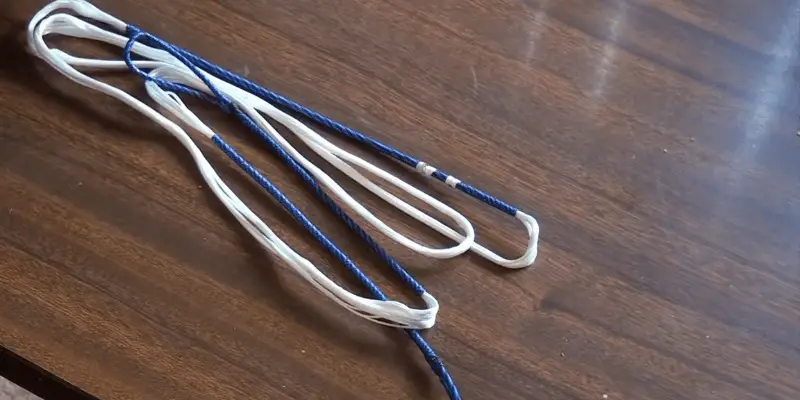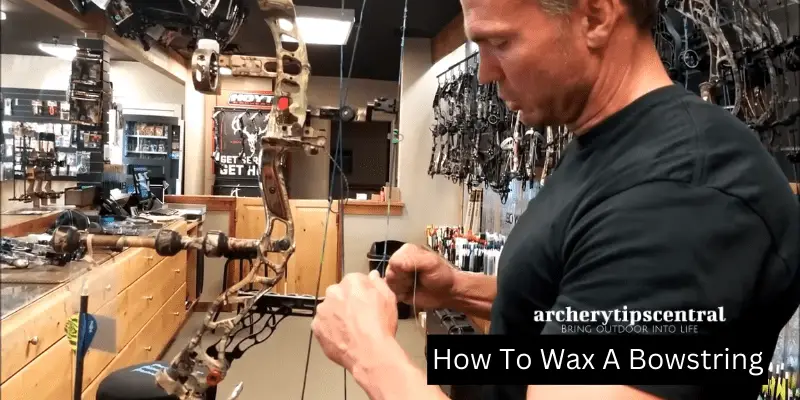I just started archery hunting a few months ago and am facing some serious problems with my bowstrings. Their lifespan is short; they become rough and moist easily.
One of my friends suggested waxing my bowstrings. What is it, and how do I wax a bowstring?
Waxing the bowstring is an easy and simple procedure. You can follow just three steps: Apply, rub, and remove the excess.
You can complete the process by yourself without needing the help of any technical personnel.
Sounds easy, right? Okay, follow some manageable techniques I will mention here, and enjoy your hunting even more.
Table of Contents
- Why Should You Wax Your Bow String?
- How To Wax A Crossbow String?
- How To Wax A Compound Bow String?
- How To Wax A Recurve Bowstring?
- What Is Bowstring Wax Made Of?
- How To Know You Have Done Your Bowstring Waxing Correctly?
- FAQs
- Wrapping It Up
Why Should You Wax Your Bow String?
A long list of benefits can be easily achieved by waxing a bowstring. It can provide you with so many advantages that it appears to be the best way to maintain a bow.
Waxing increases longevity and prevents your string from fraying, keeping it free from water, which keeps the bowstring lighter and prevents twists.
Waxing can result in a smooth flow of your bow, long-lasting lubrication, and a tacky feel.
Let’s delve deeper into the benefits of waxing your bowstring:
- The increasing lifespan of bowstrings.
- Burnishes your game moves.
- Easy to process in the field too.
- No need for any professional kit.
- Performs as an all-weather shield.
How To Wax A Crossbow String?
Waxing the bowstring is something that every shooter should do every couple of weeks and when they’re using their bow.
The advantages of it are massive; we already knew that. So the next question is, how to wax a bowstring?
Follow these steps and make your shots perfect.
Step 1: Apply The Wax
Before starting this process, first, inspect your bowstring’s condition. Make sure it is clear and dust-free.
Otherwise, clean it first.
Select the best wax for your bowstring. Choosing the best wax is a valuable tip for achieving good results in the waxing process.
Check Bow String Wax Pricing on AmazonSynthetic waxes are the better option for an archer. Bohning Tex-Tite, Allen Crossbow Wax, and Scorpion Venom Polymeric Bowstring Wax are just a few.
After selecting the wax, start applying it to the bowstring and rub it up and down. Apply a sufficient amount of wax to achieve better results.
Additionally, it is a good practice to lubricate your bow rail. For that, simply touch the wax on the rail several times and rub it.
Step 2: Rubbing The Wax In
For this, use your fingers to rub properly. Also use the thumb to create more pressure on it, so that wax can melt and then penetrate all layers of string properly and cover the entire surface.
Step 3: Remove Excess Wax
Okay, the previous 2 steps done? Now, take a soft fabric and a clean cloth, and remove the excess wax from the string.
A significant portion of excess wax usually accumulates in the string servings. Hence, work the cloth carefully so as not to smudge them.
If the wax removal process is finished, then waxing your bowstring is completed. Congratulations!
What are the alternatives to bowstring wax if you don’t have any? Beeswax, candle wax, dubbing wax, waterproofing wax, and snowboard wax can be the alternative to bowstring wax.
How To Wax A Compound Bow String?

So, big question is, waxing a traditional bowstring and a compound bowstring is same? Yes, the procedure is almost the same. But it requires some extra care while waxing.
- Firstly, you need to have all the cables of the cable slides. Take the wax then, and start applying it to the strings properly. Be careful so that wax can’t enter any other servings.
- Then for cables, do the same things. Don’t use wax on the peep side of the string. It can cause harm by becoming slippery.
- Use a piece of leather or your finger to create pressure as the wax can melt it down and penetrate the string and cables properly.
The procedure is done. Easy right? Do it every 2 to 3 weeks for getting the desired outcomes.
How To Wax A Recurve Bowstring?
The recurve bowstring is one of the uncomplicated types of bowstrings, which is a promising option for novices in the hunting field.
It is comfortable to operate and also delivers energy more efficiently. So, the question is, how much waxing is needed for recurve bows and how can it be done?
The waxing process for recurve bowstrings is as simple as the other traditional waxing processes. You can follow the instructions that I mentioned above.
Moreover, it is easier than with any other bow because the construction of recurve bows is simpler, and all the procedures can be easily completed.
What Is Bowstring Wax Made Of?
It’s not a less critical question: what is bowstring wax made of? Beeswax is the primary material in bowstring waxes.
Various other types of ingredients are also added to beeswax for the preparation of bowstring waxes.
Pine tar, pipe tar, olive oil, cocoa butter, etc., are mixed to create bowstring wax in addition to beeswax.
Synthetic waxes (this link will take you to synthetic wax) are the best option for synthetic bowstrings. Archers can also create their own recipes using beeswax and other materials by themselves.
How To Know You Have Done Your Bowstring Waxing Correctly?
While waxing is a useful maintenance practice that all archers need to follow, it is equally crucial to wax the string properly.
Applying too much wax or too little wax will prevent you from achieving the desired results of waxing.
It’s essential to perform the waxing appropriately. The next question may arise in your mind: How to know if you have done your bowstring waxing correctly?
Well, properly done waxing brings a gooey, sticky feel to your strings and improves your shooting significantly, making it smoother. Therefore, you can assume that you’ve done the job correctly.
FAQs
How to wax Barnett crossbow strings?
The application of wax on the Barnett crossbow strings is similar to the normal waxing process of traditional bowstrings.
Just follow the easy procedures of waxing bowstrings. Apply wax simply, then rub it and remove the extra waxes. As simple as that.
How to wax Ravin crossbow string?
The procedure of waxing on Ravin crossbow strings hasn’t any dissimilarities from other crossbow string waxing. Apply a liberal amount of wax and rub them. Do not wax the center of the serving, just keep it in mind.
Can you put too much wax on a bowstring?
Yes! You can put too much wax on a bowstring. Using a sufficient amount of wax can support you retain your expected results in waxing.
It assists to penetrate waxes adequately in all the layers of the string. But you also need to remove excess wax properly. Otherwise, it will be detrimental to your strings.
Are rail lube and string wax the same?
Though outcomes of using these two things are quite similar, using them for getting good developments of the bow.
But rail lube used in the rail creates a slippery surface for the string and minimizes friction. On the other hand, the function of wax is different enough.
Can you use Chapstick as bow wax?
Yes! You can put too much wax on a bowstring. Using a sufficient amount of wax can support you retain your expected results in waxing.
It assists to penetrate waxes adequately in all the layers of the string. But you also need to remove excess wax properly. Otherwise, it will be detrimental to your strings.
Wrapping It Up
If you can maintain your bowstring properly, hunting will be fun. And one of the simplest strategies for maintaining a bowstring is waxing. It is a straightforward and easy technique.
Although the technique may vary with different types of bows, it is simple and can be easily done by you without any special treatments.

